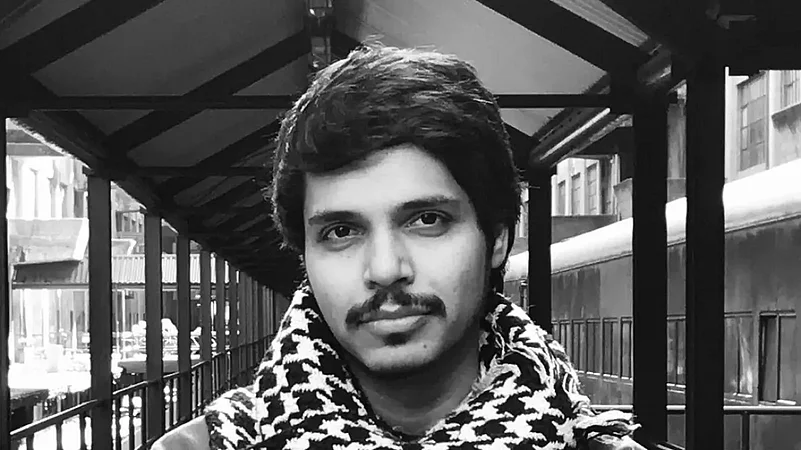Aditya Srinivas Mopidevi, a curator of art exhibitions, recalled how the pandemic threw him and many of his peers into an abyss. "The accessibility and engagement that art strives for suddenly paused. In the early days, I remember all of us were clueless about how things will unfold, both in terms of life and art," said the Curator of Terrain.art, an NFT platform for South Asian artists.

Fortunately, virtual exhibitions, online viewing rooms, zoom panel discussions, online initiatives and Insta live conversations soon became a norm. Unwilling to let the pandemic beat them, the Indian art world built a bridge, leveraging technological interventions, to connect with their audience.
Technology To Build Community
Barring a few, most art galleries in India had remained reticent when it came to technology adoption. That does not mean they shied away from showcasing digital art, which uses technology as a medium. However, the pandemic shook things up substantially when nationwide lockdowns were imposed.
Philanthropist and art collector Feroze Gujral, who, along with her husband Mohit Gujral, runs the non-profit The Gujral Foundation, puts things into perspective. "There are two levels that technology works on. The first is as a medium—where I am quite interested in NFT drops and keenly watching the developments—and the second is where it is used as a medium for communication where I am quite interested in buying online.
Earlier, one had to go to a gallery, see the work and make a payment. However, now galleries send very detailed hi-resolution photographs of the works and a film. One can speak to the artist, see the viewing room, and then buy the artwork," Gujral stated.
She recently started an online platform, 'Artdemic', to support young artists from nondescript towns, remote villages and cities to help them continue their art journey during the Delta wave. The platform will announce open calls for artists to submit their work following, which they would be given microgrants.
To date, Artdemic has offered grants to several artists. "So, I used technology very simply to build a community. We helped them get recognition. One of our artists, Anshuka Mahapatra, got the opportunity to design the facade of the India Art Fair this time. Artdemic is very special and going to get bigger in its scope," Gujral proudly added.
Collaborative Online Platforms
Watching a piece of art is akin to an intimate dialogue between the viewer and the artwork. The niche community of art collectors and enthusiasts look forward to such interactions in the form of art openings, gallery visits, and panel discussions with artists to not just delight in the sublime creations or buy the work but also gain insights into the creative process.
The arts ecosystem was unaware of any other mode of bringing art aficionados closer to the world of art. COVID-19 and ensuing lockdowns upended this state of bliss, as the unprecedented lockdowns encompassed art galleries, which thrived on physical interactions.
In 2020, around ten galleries—Experimenter from Kolkata, Chemould Prescott Road (Mumbai), Gallery Espace (New Delhi), Green Art Gallery (Dubai), Grey Noise (Dubai), Nature Morte (New Delhi), PHOTOINK (New Delhi), GALLERYSKE (Bangalore/New Delhi), The Third Line (Dubai) and Vadehra Art Gallery (New Delhi)—collaborated to form Art In Touch, an online digital exhibitions platform to present curated shows. Each gallery had a dedicated section to present its exhibition. So far, it has held seven editions that saw the participation of 1,50,000 visitors, a number that these entities were unlikely to achieve in physical shows.
Priyanka Raja, co-founder and Director of Kolkata-based Experimenter and one of the founding members of Art In Touch, explained, "We used technology to build a unified platform; an experiment that worked. This is truly a collaborative approach and is here to stay. We have just upgraded the website."
As for her gallery, Experimenter, Raja recalled rolling out online initiatives like Experimenter Labs for research and experiments, Experimenter Black Box for digital art projects and Generator for art production funds.
Art Boom During Pandemic Lull
Interestingly, the art market boomed during the pandemic, evidenced by the record prices that artworks fetched in auctions. Conducted through a live webcast, a 1961 oil on canvas by VS Gaitonde went under the hammer for Rs.39.98 crore during Saffronart's spring live auction in March 2021.
The auction achieved a combined sales value of almost Rs 79 crore. Saffronart's live and online spring auctions earned a combined sale value of Rs 115.62 crore this year.
"The online presence was the only way to see or buy online art at the time. People at times feel intimidated entering physical galleries. But it was easier to ask questions, view and engage on a virtual platform. So, an entirely new crop of young collectors emerged because the galleries went digital," contemplated Roshini Vadehra, Director, Vadehra Art Gallery (VAG), which happens to be one of the oldest art galleries in the country. Nonetheless, VAG was mindful of putting up low-value works ranging between $1000 and $10,000 by young artists on the platform to encourage new patrons and recorded 80 per cent sales for Shailesh BR's works.
Hybrid Model Is Here To Stay
With the waning of COVID-19 cases and easing restrictions, the art season is in full swing, this time physically, with a line-up of stellar art openings, art fairs and whatnot. The roaring success of the India Art Fair, which made a comeback as a physical event after two years, demonstrated that the virtual art world still has a long way to go when matching the verve of in-person affairs.
At the same time, the fraternity is conscious of the unpredictable virus and is willing to bank on technology to tackle similar situations in the future. Art galleries have come to terms with the fact that hybrid models in which their physical spaces will co-exist with their online presence.
Art gallery Latitude 28 in Delhi has started sending digital catalogs with installation and display shots of exhibitions along with high-resolution images of artworks. For cloud storage, it has employed digital platforms, such as Artlogic and Artsy.
The Delhi-based gallery is also working towards digitizing its stock and making it live online. With organized and streamlined inventory, it sends curated preview links to its clients and patrons so they can peruse the works they are interested in. Latitude 28 has also built a digital archive of its 100-plus exhibitions on its website.
Bhavna Kakar, Director, Latitude 28, elaborated, "Now that physical spaces are reopening, we have introduced our new exhibition 'World Awaits You Like a Garden', which reflects the history of Gardens and its significance in contemporary times. We hope to see exciting numbers of people rushing into the gallery for our exhibition and the art ecosystem. Even though the threat of another wave is still looming over us, to a great extent, we are relieved that at least we have the digital format at our disposal now."

The gallery had many virtual showings during and after the pandemic, including walkthroughs of shows like 'Marks in Time/ Through Time' and 'Phantasmagoria' on Instagram. "Interestingly, Instagram has emerged as an atypical viewing room as we upload bits from our shows and images of artworks with details there which fetches us a great response since many inquiries come straight to our comments section and DMs," Kakar noted.
Investing In Online Viewing Rooms
Even as the viscerality of art remains absent in online showcases, some galleries are investing in the expensive proposition of setting up 3D online viewing rooms to give viewers an immersive experience. Top-notch art fairs like Frieze Art Fair in London and Art Basel showcased a panorama of artworks worldwide through online viewing rooms.
An online viewing room is an immersive presentation of artworks in a 3-D setting interspersed with videos, audio and background information. It costs anywhere between Rs.3 lakh and Rs.10 lakh.
Art collector and curator Arjun Sawhney was taken aback at the response received by 'Future Is Not Fixed', an online show he curated in collaboration with VAG and Nature Morte Gallery in 2020. It featured artists including Atul Dodiya, Faiza Butt, Gigi Scaria, and Ranbir Kaleka.
With 2500 virtual visitors, the show recorded over 60 per cent sales. Sawhney says in a physical showcase, a limited number of people can visit the show, but thousands of people can access virtual presentations. "The gallery sends the viewing link to its entire database. I think the virtual art world is here to stay," he reiterated.
Directly Selling On Social Media
Stepping outside the comfort zone of the gallery ecosystem, artists Purvai Rai and Ayesha Singh launched #ArtChainIndia in 2020. This peer-support initiative enables artists to buy or sell their work priced between Rs.500 and Rs.10000 on social media. Today over 16,000 artworks by artists are uploaded on this network.
This year, Art Chain India is readjusting the price cap so that artists can offer their work at the price they deem fit. In an email interview, Art Chain India revealed that its scope would only widen with time. "This year, we will be focusing on translating the resources we provide to more languages spoken in India and to expand our resources for artists selling work and those looking for legal assistance and guidance," the company's spokesperson stated.
While technology has proved to be a game-changer for the art world over the past couple of years, it has its share of downside. Artist Sudarshan Shetty opined, "These ways of dissemination can help reach more people, but on the other hand, it produces a deafening amount of noise. Artists must find it difficult for their work to be experienced in a contemplative space, bringing us to the question of the 'function' of art. We are moving into a future where the very 'function' of art (as we understand it now) will be entirely lost. Moreover, the social need for 'art', the way it functions now, will be replaced with something entirely driven and foregrounded by technological innovations or other big world events. This is not to say that, for artists, a deep personal need to 'make' objects, tangible or intangible, will ever be diminished," he cautioned.
Take Note
a) Indian art sales in auctions rose from Rs.13 crore in 2000 to over Rs 880 crore in 2020-21.
b) The financial year 2020-2021 was the best year for the Indian art auction market.
c) Online auctions increased from 49 in 2019-2020 to 105 in 2020-2021
(Source: State of Art Market Report 2021)


























